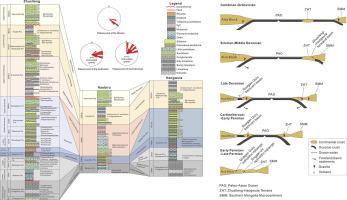Gondwana Research ( IF 7.2 ) Pub Date : 2021-07-24 , DOI: 10.1016/j.gr.2021.07.019 Beihang Zhang 1 , Jin Zhang 1 , Rongguo Zheng 1 , Junfeng Qu 1 , Jie Hui 2 , Heng Zhao 1 , Shuo Zhao 1 , Pengfei Niu 1 , Yiping Zhang 3 , Long Yun 4

|
Long-lived subduction and accretion of the Paleo-Asian Ocean (PAO) led to the formation of the Central Asian Orogenic Belt (CAOB). The central part of the southern CAOB is crucial to understand the tectonic evolution of the entire CAOB. However, the Paleozoic evolution and the final closure of the central PAO are controversial, and the nature of the Early Paleozoic basins is confusing. The relatively complete Paleozoic strata are well-preserved in Zhusileng area in the central part of the southern CAOB and provide an ideal object to constrain the Paleozoic tectonic setting of the PAO. In this study, detrital zircon U-Pb dating and sedimentological and paleocurrents analyses are conducted on the Cambrian-Devonian strata and Lower Permian strata. Most detrital zircons from the Cambrian-Devonian strata have Precambrian ages, while the detrital zircons from the Lower Permian strata are mainly of Paleozoic age. The North China Craton, Alxa Block and Tarim Craton are not the provenances of the Cambrian-Devonian strata. The central part of the southern CAOB was located in a passive continental margin setting during the Cambrian to Ordovician and received the detritus from the Beishan Orogenic Belt. During the Silurian to Middle Devonian, a nearly east-west-trending foreland basin that resulted from the collision between the Zhusileng-Hangwula terrane and southern Mongolian microcontinent developed. From the Late Devonian to Early Permian, bidirectional subduction of the PAO occurred between the Alxa Block and Zhusileng-Hangwula terrane, resulting in numerous arc-related magmatic rocks. Detritus in the Lower Permian strata was mainly from the Paleozoic magmatic rocks and Cambrian-Devonian strata in Zhusileng and surrounding areas. The Late Paleozoic shortening deformation and the switch of the tectonic setting from subduction/collision to post-collision occurred in the central part of the southern CAOB imply that the central PAO closed between the Early and Late Permian.
中文翻译:

中亚造山带南部中部古生代构造演化:来自碎屑锆石U-Pb年龄和沉积特征的约束
古亚洲洋(PAO)的长期俯冲和增生导致中亚造山带(CAOB)的形成。CAOB南部的中部对于了解整个CAOB的构造演化至关重要。然而,古生代演化和中央PAO的最终闭合存在争议,早古生代盆地的性质令人困惑。中亚盆地南部中部朱斯棱地区保存较完整的古生界地层,为制约大洋洲古生界构造环境提供了理想对象。本研究对寒武纪-泥盆纪地层和下二叠纪地层进行碎屑锆石U-Pb定年、沉积学和古洋流分析。大多数寒武纪-泥盆纪碎屑锆石具有前寒武纪年龄,而下二叠统地层碎屑锆石主要为古生代。华北克拉通、阿拉善地块和塔里木克拉通并非寒武系-泥盆系地层物源。中亚盆地南部中部处于寒武纪至奥陶纪的被动大陆边缘环境,接收北山造山带碎屑。志留系至中泥盆世,朱斯棱—杭乌拉地体与蒙古南部微大陆碰撞形成近东西走向的前陆盆地。晚泥盆世至早二叠世,阿拉善地块与朱斯棱—杭乌拉地体之间发生了PAO的双向俯冲作用,形成了大量的弧形岩浆岩。下二叠统地层碎屑主要来自朱斯棱及周边地区的古生代岩浆岩和寒武系-泥盆系地层。CAOB南部中部发生的晚古生代缩短变形和构造环境从俯冲/碰撞向后碰撞的转换意味着中央PAO在早二叠世和晚二叠世之间闭合。










































 京公网安备 11010802027423号
京公网安备 11010802027423号